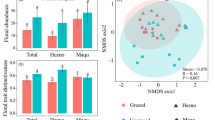Abstract
Eichhornia azurea is a tristylous species of Pontederiaceae. Moderate self-incompatibility accompanies the floral heteromorphism of this species.Eichhornia azurea is almost exclusively visited by one bee species,Ancyloscelis gigas (Anthophoridae), in South Brazil. This species has an extremely long proboscis covered with recurved hairs. Bees use these hairs to collect pollen from the anthers placed inside the narrow perianth tube ofE. azurea. Analyses of the pollen load ofA. gigas females show that they are flower constant and carry pollen from all three anther levels. The behavior ofA. gigas and its proboscis morphology make this bee species narrowly adapted and an effective pollinator for facilitating legitimate pollination ofE. azurea flowers in southern Brazil.
Similar content being viewed by others
References
Alves dos Santos I. (1997) Melittophilous plants, their pollen and flower visiting bees in Southern Brazil: 3. Pontederiaceae. Biociências 5 (2): 3–18.
Alves dos Santos I., Wittmann D. (1999) The proboscis of the long-tonguedAncyloscelis bees (Anthophoridae/Apoidea), with remarks on flowers visits and pollen collecting with the mouth parts. J. Kansas Entomol. Soc. 72 (3): 253–264.
Barrett S. C. H. (1978) Floral biology ofEichhornia azurea (Swartz) Kunth (Pontederiaceae). Aquatic Bot. 5: 217–228.
Barrett S. C. H. (1980) Sexual reproduction inEichhornia crassipes (Water Hyacinth) II. Seed production in natural populations. J. Appl. Ecology 17: 113–124.
Barrett S. C. H. (1985) Floral trimorphism and monomorphism in continental and island populations ofEichhornia paniculata (Spreng.) Solms. (Pontederiaceae). Biol. J. Linn. Soc. 25: 41–60.
Barrett S. C. H. (1988) Evolution of Breeding Systems inEichhornia (Pontederiaceae): a Review. Ann. Missouri Bot. Gard. 75 (3): 741–760.
Barrett S. C. H. (1993) The Evolutionary biology of tristyly. In: Futuyama D., Antonovics J. (eds.) Oxford Surveys in Evolutionary Biology. Vol. 9. Oxford University Press, Oxford, UK, pp 283–326.
Barrett S. C. H., Glover D. E. (1985) On the Darwinian hypothesis of the adaptive significance of tristyly. Evolution 39: 766–774.
Barrett S. C. H., Husband B. (1990) Variation in outcrossing rates inEichhornia paniculata: the role of demographic and reproductive factors. Plant Species Biol. 5: 41–55.
Barrett S. C. H., Kohn J. R., Cruzan M. B. (1992) Experimental studies of mating-system evolution: the marriage of marker genes and floral biology. In: Wyatt R. (ed.) Ecology and evolution of plant reproduction: new perspectives. Chapman and Hall, NY, pp. 193–230.
Barrett S. C. H., Morgan M. T., Husband B. (1989) The dissolution of a complex genetic polymorphism: the evolution of self-fertilization in tristylousEichhornia paniculata (Pontederiaceae). Evolution 43 (7): 1398–1416.
Bawa K. S., Beach J. H. (1981) Evolution of sexual systems in flowering plants. Ann. Missouri Bot. Gard. 68: 254–274.
Charlesworth D. (1979) The evolution and breakdown of tristyly. Evolution 33 (1): 486–498.
Darwin C. (1877) The different forms of flowers on plants of the same species. John Murray, London, U.K.
Ganders F. R. (1979) The biology of heterostyly. New Zealand J. Bot. 17: 607–635.
Glover D. E., Barrett S. C. H. (1983) Trimorphic incompatibility in Mexican populations ofPontederia sagittata Presl. (Pontederiaceae). New Phytol. 95: 439–455.
Glover D. E., Barrett S. C. H. (1986) Variation in the mating system ofEichhornia paniculata (Spreng.) Solms. (Pontederiaceae). Evolution 40 (6): 1122–1131.
Glover D. E., Barrett S. C. H. (1987) Genetic variation in continental and island populations ofEichhornia paniculata (Pontederiaceae). Heredity 59: 7–17.
Harder L. D., Barrett S. C. H. (1992) The energy cost of bee pollination forPontederia cordata (Pontederiaceae). Functional Ecol. 6: 226–233.
Harder L. D., Barrett S. C. H. (1993) Pollen removal from tristylousPontederia cordata: effects of anther position and pollinator specialization. Ecology 74 (4): 1059–1072.
Husband B. C., Barrett S. C. H. (1992) Pollinator visitation in populations of tristylousEichhornia paniculata in northeastern Brazil. Oecologia 89 (3): 365–371.
Kohn J. R., Barrett S. C. H. (1992) Experimental studies on the functional significance of heterostyly. Evolution 46 (1): 43–55.
LaBerge W. E. (1956) A revision of the bees of the genusMelissodes in North and Central America. Part II (Hymenoptera, Apidae). Univ. Kansas Sci. Bull. 38: 533–578.
Price S. D., Barrett S. C. H. (1982) Tristyly inPontederia cordata (Pontederiaceae). Can. J. Bot. 60: 897–905.
Richards J. H., Barrett S. C. H. (1984) The developmental basis of tristyly inEichhornia paniculata (Pontederiaceae). Amer. J. Bot. 71: 1347–1363.
Thompson J. D., Pailler T., Strasberg D., Manicacci D. (1996) Tristyly in the endangered Mascarene Island endemicHugonia serrata (Linaceae). Amer. J. Bot. 83 (9): 1160–1167.
Vuilleumier B. S. (1967) The origin and evolutionary development of heterostyly in the angiosperms. Evolution 21: 210–226.
Westerkamp C. (1996) Pollen in Bee-Flower Relations, Some Considerations on Melittophily. Bot. Acta 109: 325–332.
Wolfe L. M., Barrett S. C. H. (1988) Temporal changes in the pollinator fauna of tristylousPontederia cordata, an aquatic plant. Can. J. Zool. 66: 1421–1424.
Wolfe L. M., Barrett S. C. H. (1989) Patterns of pollen removal and deposition in tristylousPontederia cordata L. (Pontederiaceae). Biol. J. Linn. Soc. 36: 317–329.
Author information
Authors and Affiliations
Rights and permissions
About this article
Cite this article
Alves Dos Santos, I., Wittmann, D. Legitimate pollination of the tristylous flowers ofEichhornia azurea (Pontederiaceae) byAncyloscelis gigas bees (Anthophoridae, Apoidea). Pl Syst Evol 223, 127–137 (2000). https://doi.org/10.1007/BF00985274
Received:
Accepted:
Issue Date:
DOI: https://doi.org/10.1007/BF00985274




